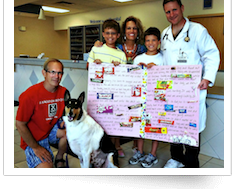A Dog Having a Really “Ruff” Week
Written by: Sam T. • 2016 Scholar
Meet “Phoebe” Kurtz
Age: 10 years
Sex: Spayed female
Species: Canine
Breed: Beagle mix
Weight: 24.8#
Phoebe came to see us at Iowa Veterinary Specialties on referral of her primary care veterinarian. She was brought to her daytime doctor because she was vomiting, eating only a small amount and had been urinating in her owner’s home. At her regular clinic, they ran a urinalysis to check the characteristics of Phoebe’s urine since she had been having accidents in the house. The urinalysis came back with a high amount of glucose and ketones present in the urine. Ketones are acids that are a byproduct of fat break down. When enough of them built up in the blood, it becomes poisonous to the animal. This type of fat break down usually occurs when the animal can’t use glucose as a form of energy due to a lack of insulin. The high amount of glucose and ketones in the urine are indicative of diabetic ketoacidosis (DKA) – a potentially fatal condition if not corrected quickly. Upon diagnosing Phoebe with DKA she was referred to IVS for 24 hour care and hospitalization.
Once Phoebe got to us we did a physical exam on her and ran some blood work. We wanted to make sure we evaluated her blood cells (red, white and platelets), looked at organ function, and checked her electrolytes and other characteristics of her blood to make sure that we weren’t missing something and made sure to get to the underlying cause of her condition.
Her blood work revealed that she did indeed have a significantly higher than normal amount of glucose in her blood, her liver enzymes were high and she also had evidence of pancreatitis (inflammation of the pancreas). Her urinalysis, the high glucose in the blood and the acidic character of her blood confirmed a diagnosis of diabetic ketoacidosis with a concurrent pancreatitis. Dogs with DKA can be lethargic and have decreased alertness. They may have deep and rapid breathing, urinate frequently, and/or have breath that smells fruity or like acetone. They may be stiff, vomit and be painful in their stomach. Dogs who have pancreatitis usually have a painful abdomen, can have nausea and vomiting and their abdomen may be distended. On top of her DKA and pancreatitis, Phoebe also was diagnosed with Cushing’s disease or hyperadrenocorticism earlier in her life. This condition, when not treated, causes the body to release too much cortisol which can contribute to hyperglycemia (high blood sugar). To get Phoebe feeling better it was important to find a balance and make sure everything going on was managed properly.
The first plan of action was to get an IV catheter in her so we could start administering fluids and insulin. It was important to get her the insulin so her body could start to counteract the hyperglycemia. She also had a solution of 2.5% Dextrose solution that she could be hooked up to if her blood glucose fell too low. She continued to take her medication for Cushing’s and she was also given an anti-nausea medication for her pancreatitis. Because Phoebe’s blood was becoming acidic she was given a solution of NaHCO3 to counteract the acidity and her fluids also had KCl (potassium chloride) added because her potassium levels were low.
Every other hour, technicians were monitoring Phoebe’s blood glucose and adjusting her insulin CRI (Constant Rate Infusion) and dextrose levels accordingly to make sure her body stayed in a balanced state. She did develop some bloody diarrhea while she was here with us but that cleared up a day into her stay with the addition of an antibiotic to her treatment. After she started eating on her own she was switched to oral medications and she was taken off the anti-nausea medication. She was also switched to long-actinginsulin given under the skin instead of the insulin CRI to switch her over to her long term therapy as insulin will be needed lifelong. It is important NOT to give insulin if the animal is NOT eating or doesn’t have a supply of sugar because the body can become severely hypoglycemic.
Phoebe progressed very well over the course of 3 days at IVS and was discharged to her owner after 3 nights in the hospital. She was sent home with an antibiotic for her diarrhea and Vetsulin (insulin) for her diabetes. We recommended that in 7-10 days she see her regular veterinarian to have her glucose levels monitored to see how she is responding to the insulin therapy and if she is getting adequate doses. We were very happy to see Phoebe respond so well!




